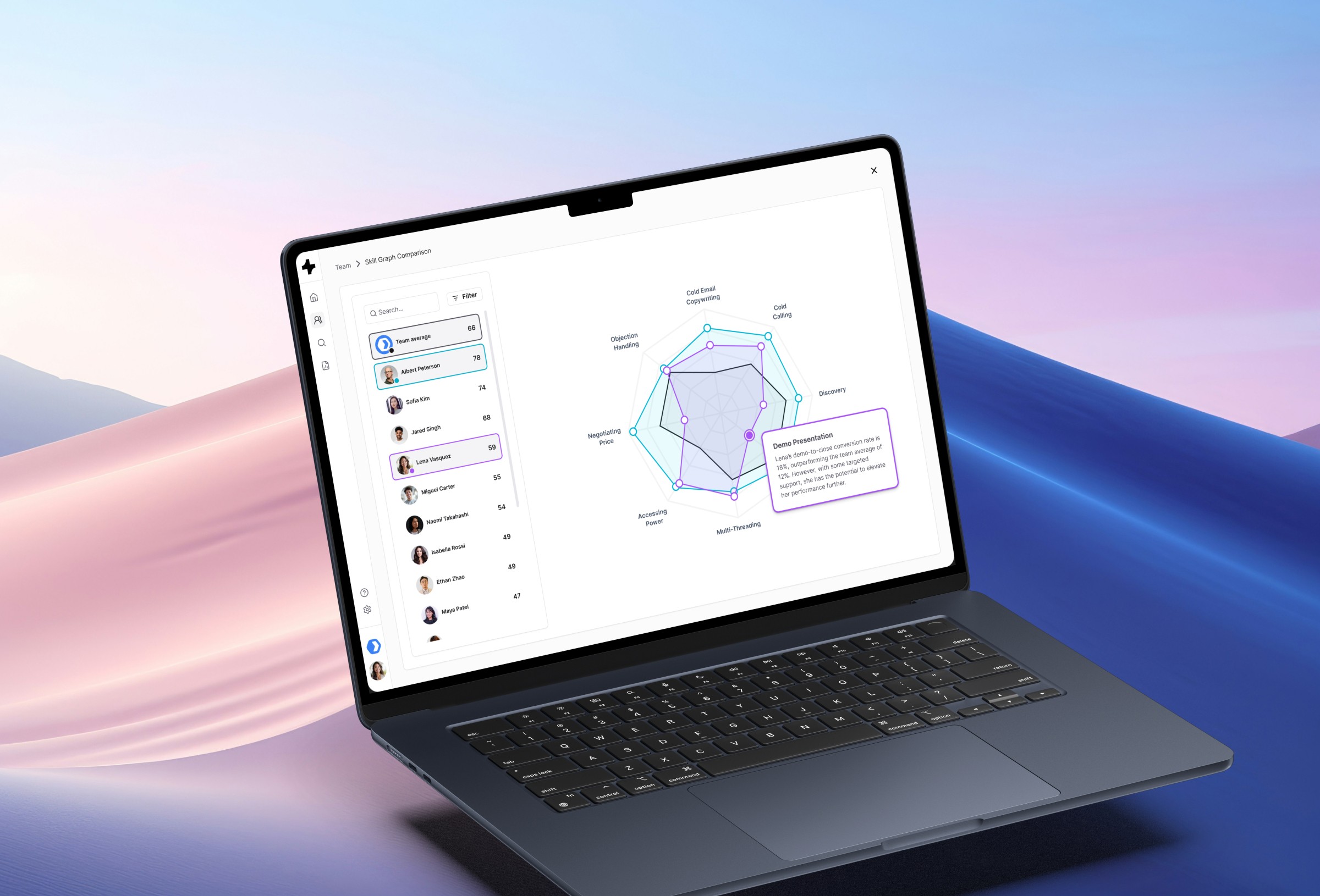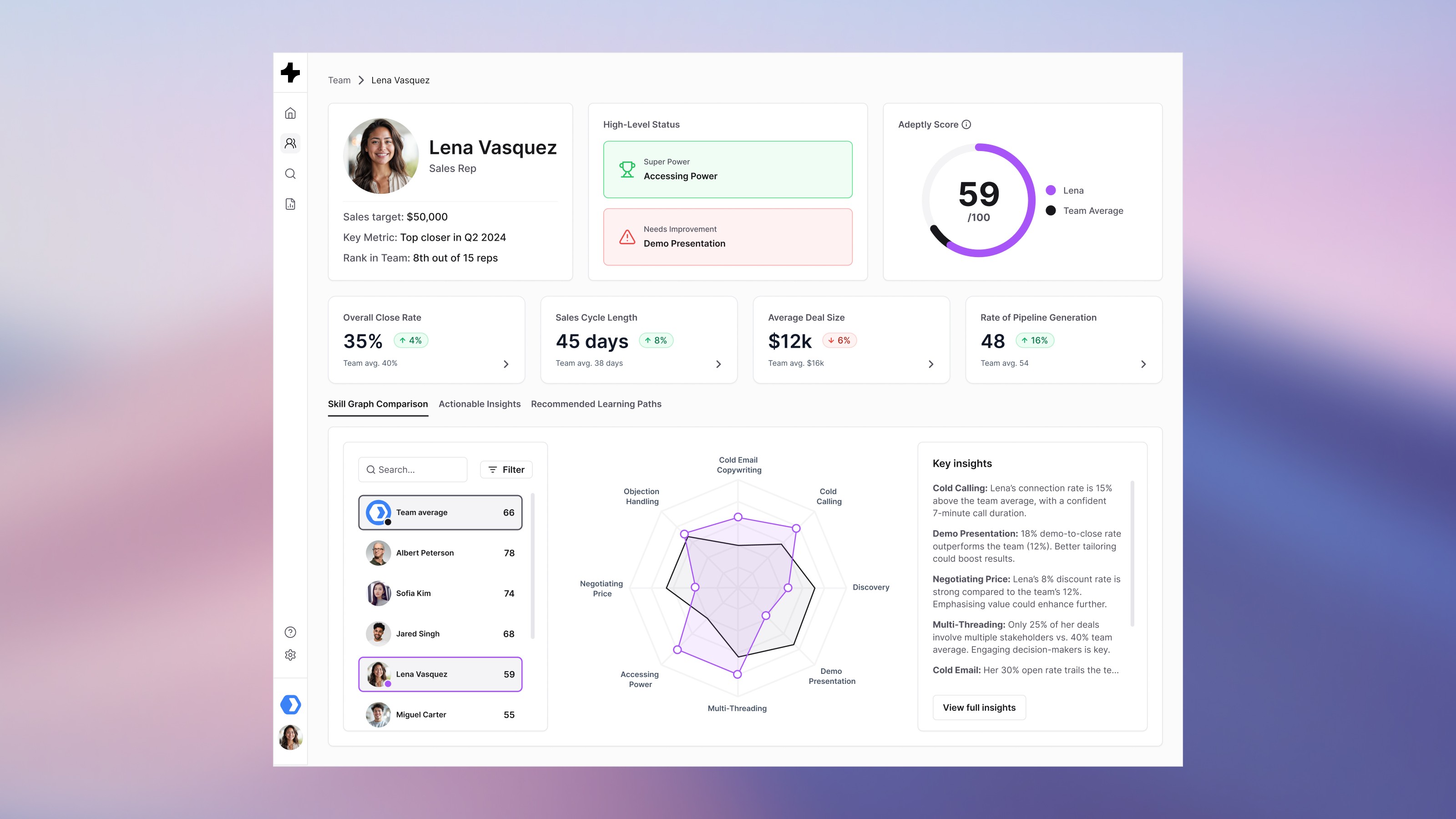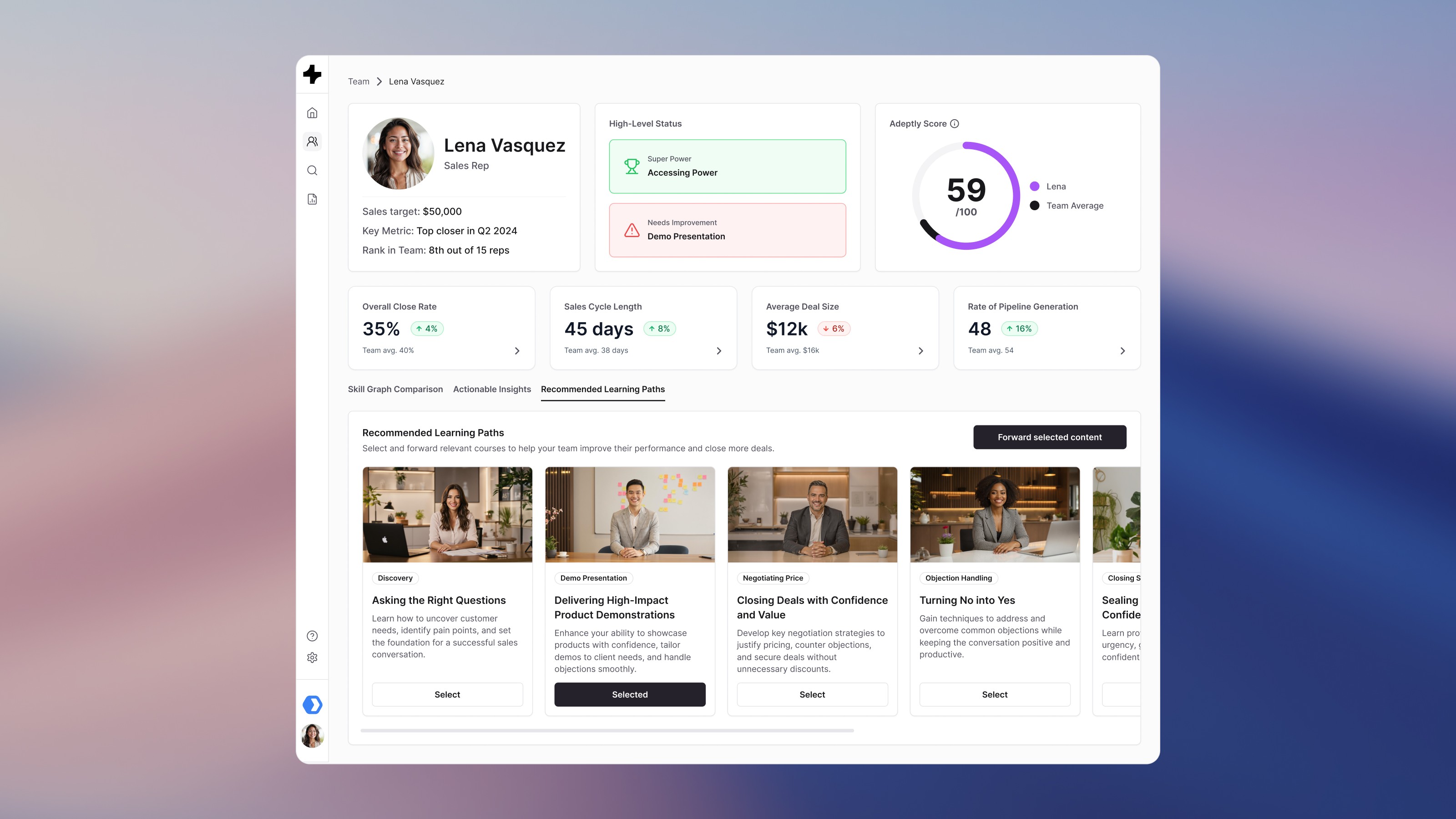Adeptly
Adeptly
/24


Problem
Sales teams lack critical skills insights.
They have performance metrics like close rates, deal sizes, and conversion rates, but no one knows why certain sales reps succeed while others struggle. There is no system in place to track specific skills like cold calling, negotiation, or objection handling.
Adeptly, an online course provider, wanted to evolve beyond training and into measuring and improving sales performance through data-driven insights. They envisioned a skills platform that would identify skill gaps and provide tailored learning recommendations.
Key Challenges
Sales leaders lacked visibility into the why behind performance differences.
Clients needed a way to track skill progression beyond just completed courses.
The project had a tight budget and timeline, requiring lean methodologies.
I was the sole designer and project manager, leading the strategy and execution.
The platform had to integrate with Adeptly’s existing SaaS infrastructure seamlessly.
Note: Due to current access limitations, I can currently only share the Sales Manager view of a sales employee page in this case study.
Problem
Sales teams lack critical skills insights.
They have performance metrics like close rates, deal sizes, and conversion rates, but no one knows why certain sales reps succeed while others struggle. There is no system in place to track specific skills like cold calling, negotiation, or objection handling.
Adeptly, an online course provider, wanted to evolve beyond training and into measuring and improving sales performance through data-driven insights. They envisioned a skills platform that would identify skill gaps and provide tailored learning recommendations.
Key Challenges
Sales leaders lacked visibility into the why behind performance differences.
Clients needed a way to track skill progression beyond just completed courses.
The project had a tight budget and timeline, requiring lean methodologies.
I was the sole designer and project manager, leading the strategy and execution.
The platform had to integrate with Adeptly’s existing SaaS infrastructure seamlessly.
Note: Due to current access limitations, I can currently only share the Sales Manager view of a sales employee page in this case study.
Problem
Sales teams lack critical skills insights.
They have performance metrics like close rates, deal sizes, and conversion rates, but no one knows why certain sales reps succeed while others struggle. There is no system in place to track specific skills like cold calling, negotiation, or objection handling.
Adeptly, an online course provider, wanted to evolve beyond training and into measuring and improving sales performance through data-driven insights. They envisioned a skills platform that would identify skill gaps and provide tailored learning recommendations.
Key Challenges
Sales leaders lacked visibility into the why behind performance differences.
Clients needed a way to track skill progression beyond just completed courses.
The project had a tight budget and timeline, requiring lean methodologies.
I was the sole designer and project manager, leading the strategy and execution.
The platform had to integrate with Adeptly’s existing SaaS infrastructure seamlessly.
Note: Due to current access limitations, I can currently only share the Sales Manager view of a sales employee page in this case study.
Problem
Sales teams lack critical skills insights.
They have performance metrics like close rates, deal sizes, and conversion rates, but no one knows why certain sales reps succeed while others struggle. There is no system in place to track specific skills like cold calling, negotiation, or objection handling.
Adeptly, an online course provider, wanted to evolve beyond training and into measuring and improving sales performance through data-driven insights. They envisioned a skills platform that would identify skill gaps and provide tailored learning recommendations.
Key Challenges
Sales leaders lacked visibility into the why behind performance differences.
Clients needed a way to track skill progression beyond just completed courses.
The project had a tight budget and timeline, requiring lean methodologies.
I was the sole designer and project manager, leading the strategy and execution.
The platform had to integrate with Adeptly’s existing SaaS infrastructure seamlessly.
Note: Due to current access limitations, I can currently only share the Sales Manager view of a sales employee page in this case study.
Client:
Adeptly
Client:
Adeptly
My Role:
Lead Product Designer
My Role:
Lead Product Designer
Year:
2024
Year:
2024
Service Provided:
Product Design
Service Provided:
Product Design

Solution
Lean Discovery & Strategy
Given the constraints, I chose a lean discovery approach. Instead of lengthy research phases, I sent out a pre-workshop survey to capture key info like business objectives, core problems they aim to solve, user needs, and assumptions, competitor insights etc... Then, I facilitated high-impact workshops where we:
Defined a clear problem statement
Conducted an assumption mapping exercise
Mapped the ideal customer journey
Prioritised features using MoSCoW & Impact vs Effort frameworks
I then created a feature roadmap for phased implementation.
Overcoming Challenges
The biggest hurdle? Decision-making bottlenecks.
As the sole designer and project lead, I had to push beyond my role, making strategic recommendations on big decisions such as whether the platform should be a standalone product or integrated into the existing SaaS. With internal stakeholders busy with other priorities and relying on my recommendations, I stepped up to provide proposals for pricing models and implementation strategies.
Design Execution
To keep things as lean possible, I quickly moved from wireframes to high-fidelity UI designs, ensuring a seamless user experience. I designed low-fidelity wireframes to validate flows with stakeholders, then jumped straight to high-fidelity UI based on feedback.
Solution
Lean Discovery & Strategy
Given the constraints, I chose a lean discovery approach. Instead of lengthy research phases, I sent out a pre-workshop survey to capture key info like business objectives, core problems they aim to solve, user needs, and assumptions, competitor insights etc... Then, I facilitated high-impact workshops where we:
Defined a clear problem statement
Conducted an assumption mapping exercise
Mapped the ideal customer journey
Prioritised features using MoSCoW & Impact vs Effort frameworks
I then created a feature roadmap for phased implementation.
Overcoming Challenges
The biggest hurdle? Decision-making bottlenecks.
As the sole designer and project lead, I had to push beyond my role, making strategic recommendations on big decisions such as whether the platform should be a standalone product or integrated into the existing SaaS. With internal stakeholders busy with other priorities and relying on my recommendations, I stepped up to provide proposals for pricing models and implementation strategies.
Design Execution
To keep things as lean possible, I quickly moved from wireframes to high-fidelity UI designs, ensuring a seamless user experience. I designed low-fidelity wireframes to validate flows with stakeholders, then jumped straight to high-fidelity UI based on feedback.
Solution
Lean Discovery & Strategy
Given the constraints, I chose a lean discovery approach. Instead of lengthy research phases, I sent out a pre-workshop survey to capture key info like business objectives, core problems they aim to solve, user needs, and assumptions, competitor insights etc... Then, I facilitated high-impact workshops where we:
Defined a clear problem statement
Conducted an assumption mapping exercise
Mapped the ideal customer journey
Prioritised features using MoSCoW & Impact vs Effort frameworks
I then created a feature roadmap for phased implementation.
Overcoming Challenges
The biggest hurdle? Decision-making bottlenecks.
As the sole designer and project lead, I had to push beyond my role, making strategic recommendations on big decisions such as whether the platform should be a standalone product or integrated into the existing SaaS. With internal stakeholders busy with other priorities and relying on my recommendations, I stepped up to provide proposals for pricing models and implementation strategies.
Design Execution
To keep things as lean possible, I quickly moved from wireframes to high-fidelity UI designs, ensuring a seamless user experience. I designed low-fidelity wireframes to validate flows with stakeholders, then jumped straight to high-fidelity UI based on feedback.
Solution
Lean Discovery & Strategy
Given the constraints, I chose a lean discovery approach. Instead of lengthy research phases, I sent out a pre-workshop survey to capture key info like business objectives, core problems they aim to solve, user needs, and assumptions, competitor insights etc... Then, I facilitated high-impact workshops where we:
Defined a clear problem statement
Conducted an assumption mapping exercise
Mapped the ideal customer journey
Prioritised features using MoSCoW & Impact vs Effort frameworks
I then created a feature roadmap for phased implementation.
Overcoming Challenges
The biggest hurdle? Decision-making bottlenecks.
As the sole designer and project lead, I had to push beyond my role, making strategic recommendations on big decisions such as whether the platform should be a standalone product or integrated into the existing SaaS. With internal stakeholders busy with other priorities and relying on my recommendations, I stepped up to provide proposals for pricing models and implementation strategies.
Design Execution
To keep things as lean possible, I quickly moved from wireframes to high-fidelity UI designs, ensuring a seamless user experience. I designed low-fidelity wireframes to validate flows with stakeholders, then jumped straight to high-fidelity UI based on feedback.


Impact
TBC as I left the agency before this project finished. So I wasn’t able to track any post-launch performance metrics. However, the client was extremely happy with the direction and designs, and the project laid the foundation for a scalable skill platform.
Impact
TBC as I left the agency before this project finished. So I wasn’t able to track any post-launch performance metrics. However, the client was extremely happy with the direction and designs, and the project laid the foundation for a scalable skill platform.
Impact
TBC as I left the agency before this project finished. So I wasn’t able to track any post-launch performance metrics. However, the client was extremely happy with the direction and designs, and the project laid the foundation for a scalable skill platform.
Impact
TBC as I left the agency before this project finished. So I wasn’t able to track any post-launch performance metrics. However, the client was extremely happy with the direction and designs, and the project laid the foundation for a scalable skill platform.